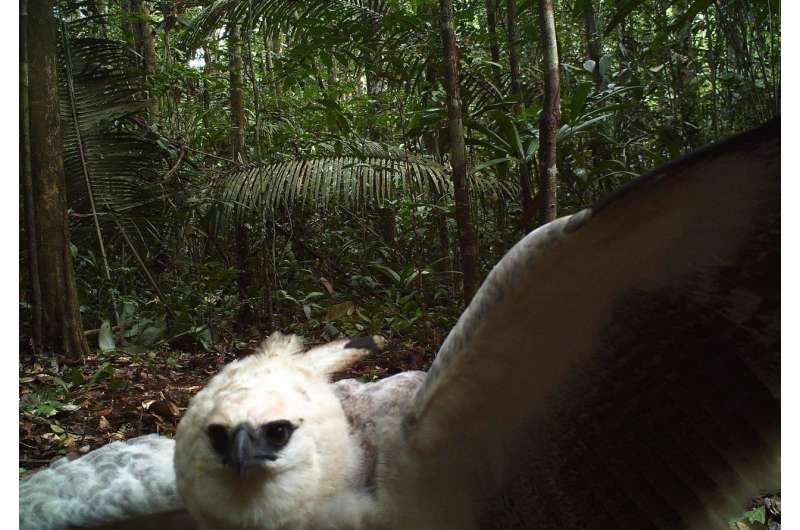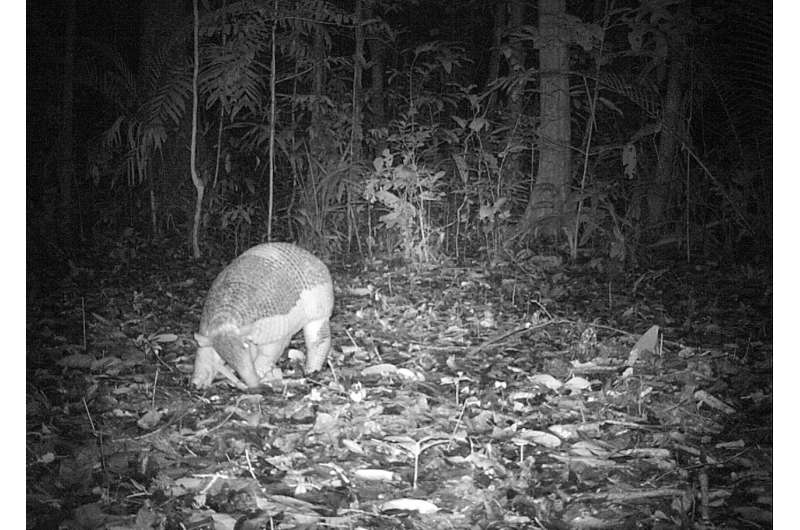Caught on camera: Amazonian crop raiders

Papped snaffling in the jungle, a striking set of photos reveal the secret lives of Amazonian crop-raiding animals.
A new study from the University of East Anglia (UK) identifies the Amazon's 'worst offending' crop destroyers - and highlights the problems caused for rural communities.
The research team spent a year working with 47 Amazonian communities in the Juruá region of Amazonas, Brazil.
They set up 132 motion-activated camera traps and took over 61,000 photos that reveal 11 crop-raiding animals, which were identified in interviews. Collared peccaries, red brocket deer, paca and agoutis are identified as the most damaging.
They also conducted 157 interviews with rural farmers to see how communities are impacted by wild animals eating their crops.
Key findings:
- Crop raiding damages the livelihoods of Amazonian communities by directly reducing crop yields, necessitating costly crop protection and reducing the range of crops that can be planted.
- The most damaging crop raiders are collared peccaries, red brocket deer, paca and agoutis.
- These species are not highly endangered and could be hunted for subsistence without threatening biodiversity.

Lead researcher Dr Mark Abrahams, from UEA's School of Environmental Sciences, said: "Conserving biodiversity is challenging for rural communities where livelihoods are sometimes threatened by wildlife. In parts of Africa and Asia for example, where elephants can destroy crops and even harm people, a bitter human-wildlife conflict may ensue, in which local communities kill wildlife and resent conservation organisations.
"Rural Amazonian communities are some of the world's poorest, but they live with the world's highest biodiversity. Their primary source of income and carbohydrates is farming manioc - which produces starchy tubers and grows well in infertile tropical soils.
"We wanted to find out how local communities are impacted by wild animals eating their crops."
The study finds that crop-raiding impacts subsistence farmers in three ways. Firstly, on average farmers lose more than 7 per cent of their manioc crop every year to crop raiders and some farmers lose their entire crop.
Secondly, farmers need to invest time and energy into protecting their crops to avoid much higher losses (roughly 10 times higher).
Finally, because more palatable 'sweet' manioc is three times more vulnerable to crop-raiding, farmers are forced to plant less of it and hide it amongst more chemically defended 'bitter' manioc. Small communities far from towns were worst impacted by crop raiding.
Despite these livelihood impacts, rural communities are not attempting to wipe out all crop-raiding animals.

Hunting with dogs and setting traps were as commonly reported as non-lethal crop protection methods such as enclosing their fields with nets.
"We found that the most damaging crop-raiding animals were collared peccaries which look similar to wild pigs, red brocket deer, paca and agoutis, which are both types of large rodents," said Dr Abrahams.
"These species are not highly endangered so hunting them for subsistence does not threaten biodiversity, as long as conservation measures like protected areas and natural resource management are put in place.
"This study shows that crop-raiding in the Amazon does not need to become a human-wildlife conflict. Conservationists can work with local communities to support their management of natural resources. Vulnerable species like spider monkeys, which do not damage livelihoods, could be protected from hunting, whilst common and damaging crop-raiders like agoutis could be hunted for subsistence.
"The community-based management of natural resources, including the hunting of crop raiders, could form part of the sustainable-use conservation strategy which is already being implemented in the Juruá region (see the Médio Juruá Project) and elsewhere in the tropics.
"Biodiversity conservation and rural development are sometimes presented as incompatible. Crop raiding has the potential to damage livelihoods and make communities hostile to conservation. In our study region however, it seems that crop raiding is not an insurmountable barrier to conservation."
Prof Carlos Peres, an author on the study from UEA's School of Environmental Sciences, said: "Coexisting side-by-side with wildlife often incurs a cost to subsistence farmers in tropical forests, which export colossal environmental services that enhance the lives of millions of people elsewhere. This asymmetry in costs and benefits at different scales should be explicitly recognised by both conservation and development policy agendas."
More information: Mark I. Abrahams et al. Manioc losses by terrestrial vertebrates in western Brazilian Amazonia, The Journal of Wildlife Management (2018). DOI: 10.1002/jwmg.21443
Journal information: Journal of Wildlife Management
Provided by University of East Anglia




















